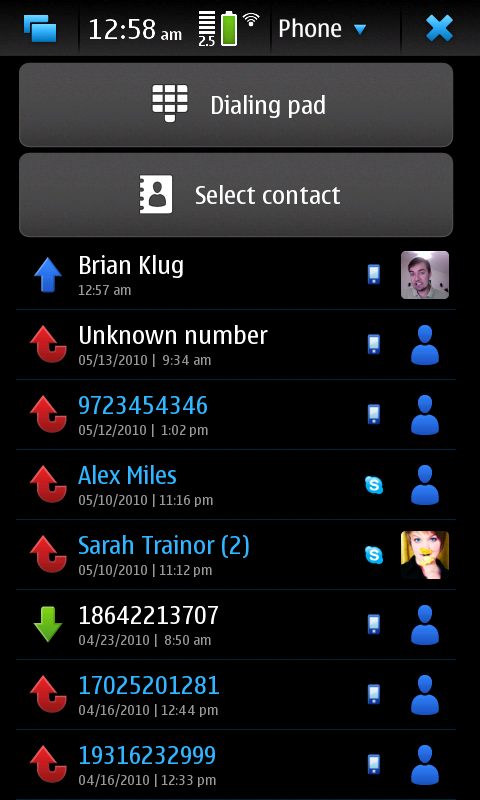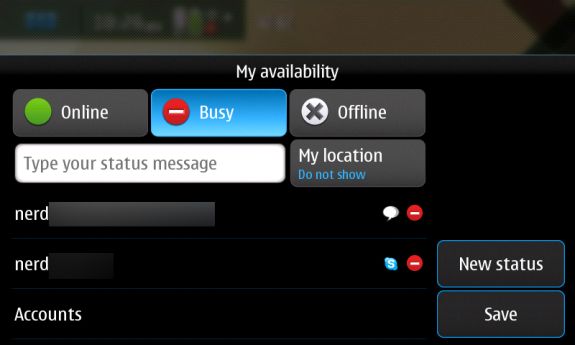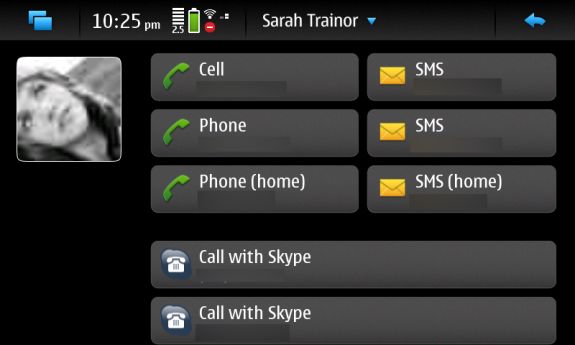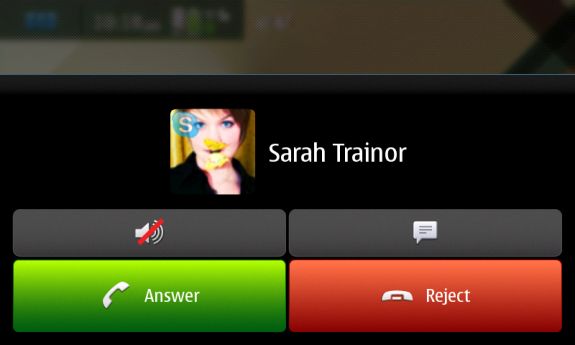Two OMAP 3430 Phones: Nokia N900 and Motorola Droid
by Brian Klug on June 10, 2010 9:29 PM EST- Posted in
- Smartphones
- N900
- Maemo
- Motorola Droid
- Droid
- MeeGo
- Android
- Mobile
Messaging and Skype
Messaging on the N900 is done in a very WebOS fashion - IMs and SMS alike are managed by the OS and aggregated into a central application called "conversations". I signed in with Google Talk and Skype, and the integration is seamless. But what's most impressive is how Skype and Google Talk handle calling. Maemo considers Google Talk and Skype VOIP and IM enabled accounts, and after they're added, you can make and receive calls over Skype, and do the same with Google Talk. Although we tested with PR 1.1, PR 1.2 further builds on this by enabling video calling for Skype (between PC and other skype video clients), and Google Talk (with the PC web client, or any other XMPP Jingle video client, including the N900, N810, and N800). There's also support for SIP video calls.
But the best part is that VOIP calls are treated just like a normal call. In fact, for a while, I was completely confused by Skype because I expected it to live by itself somewhere - similar to how it works on other platforms. But that's not how it works at all - enter your account details, set your availability status, and you're ready to call and be called over Skype. In Europe, where international calling can be expensive and sometimes confusing, this is a huge feature.
Though video calling on Android through Qik, and FaceTime on iPhone 4 has been received to much fanfare, Maemo has quietly had video call support since launch. With PR 1.1, video calling was admittedly a bit of a challenge - requiring calls to be made from the PC client of Google Talk to the N900, with the PC initiating the voice call. Or requiring Fring for Skype video calls to work (which I could never get working, sadly), but PR 1.2 now makes this a core part of the operating system in a way that really does work.
Phone Dialer
The dialer is virtually the only application that's portrait and landscape on the N900. It's admittedly very barebones. Launching it, you're first presented with a list of recently made and received calls, a shortcut to the contacts application, or the dial pad. The dial pad unfortunately doesn't have any smart dialing functions like HTC usually includes, it's just a plain ol' keypad - you can however just start typing a contact's name and see their contact card.
There's turning control for the N900 which launches the phone application whenever it's turned vertical - I never tried this - or you can force the phone to always be landscape/portrait from a setting.

Fortunately, there's landscape and portrait of both, and they do what they're supposed to do. In the call-in-progress screen, there's the usual options for mute, speaker, dial pad, and end. When you're in a skype call, there's a skype logo in the top left of the user's avatar.
When the call is over cellular, there's a picture of a phone - self explanatory. Otherwise the call screen is virtually identical for the entire gamut of call types - VOIP over 3G/2.5G or WiFi, and normal 2G/3G calling. The integration is truly flawless - there's no excuse that other platforms haven't fully integrated VoIP like this. On the other hand, carriers would throw a fit and likely never subsidize, carry, or support the phone (which might explain the N900's lack of adoption in the US), but we can dream, can't we?














68 Comments
View All Comments
Affectionate-Bed-980 - Friday, June 11, 2010 - link
You talk about the display brightness and how nice it looks, but you need to mention gamut. In some tests the 3GS shows ~65% of gamut, while the Droid shows 102%. Nexus One is at 141%. I expect the Incredible to be around there, so while the colors look nice on AMOLED, you must remember it's over-saturated and inaccurate while the Droid is spot on at 102%.fabarati - Friday, June 11, 2010 - link
I think you've misunderstood what gamut means.When a screen is advertises as 98% of the Adobe sRGB Gamut, it means that the screen covers 98% of the colours defined by Adobe for that gamut..
If it says 141% of the Adobe sRGB gamut, it means that it covers more than that defined area. It doesn't mean that the colours are oversaturated. It also doesn't mean that it can display all the colours there is.
Read up on gamuts on wikipedia:
http://en.wikipedia.org/wiki/Gamut
Powerlurker - Friday, June 11, 2010 - link
On the other hand, I doubt that anyone is going to do color correction or some sort of display calibration on their smartphone, and since most companies set their displays to be somewhat saturated by default, I would guess that in practice the Incredible's AMOLED screen will be oversaturated compared to the Droid's LCD.Brian Klug - Friday, June 11, 2010 - link
So here's the problem - there's absolutely no way to measure it. Or at least, I haven't found an acceptable solution.Going off the display panel numbers seems extremely unrealistic for obvious reasons, but barring that there are other bigger problems.
1. Android uses 16-bit color in a lot of places because they're rendering them with 3D OpenGL compositing and compressed textures. One of the most glaring - and dare I say troubling - examples is right inside the gallery application. The gallery application in 2.0.1 was full 24-bit color, but in 2.1 Google contracted with Cooliris to develop a more flashy 3D gallery. Obviously, the limitations imposed by the GPU on different devices (and possibly even from the POV of what textures are supported) necessitated 16-bits per color. In practice, it just looks awful. Without even being nitpicky, I can notice lots of banding.
2. The AMOLED displays use the PenTile array, which also does a lot of dithering inherently - in fact, their pattern is essentially trying to get around Nyquist by being very creative with the human eye system, and this intermediate software layer of theirs. The consequence is that it ends up smoothing and dithering the 16-bits, making it really hard to see the banding, but it's still there. Pull up the color gradient images from the article and scrutinize the Incredible. There's no banding, but in person, you can stlll pick out dithering and a problem.
3. I still have no way of doing gamut testing on any mobile devices. So back when I started on the iPad article, I had a (relatively clever, I think) idea to use the calibration software through a 24-bit remote desktop session, tricking it into using any mobile device like a screen. This just doesn't work for reasons outside my understanding. I've done it on iPhone OS and Android, and for some reason the results are just complete bogus. So there's no way of really telling what the % gamut coverage of Adobe 1998 any of these things are. Moreover, since there's no way of loading a display profile on them, you're really stuck with whatever it shipped with anyways.
The sad state of things is that AMOLED "looks" brighter and more contrasty, but the color accuracy is just undoubtedly wrong. I mean, it's obvious to make that comparison when you're surrounded by calibrated IPS panels with Delta-E tracking under 1.0, you hold up any of the phones, and see a veritable library of differently hued photos.
I'm open to any suggestions you guys have for really measuring gamut. I mean, we could try being more manual and laboriously testing colors one by one (that's basically how I do brightness - white, black, and contrast) but, is it worth it?
KevinToon - Friday, June 11, 2010 - link
Shouldn't the speakerphone testing be done with the devices suspended off the desk??I know my phone sounds different if it's on a hard surface like a desk.
R3MF - Friday, June 11, 2010 - link
I have an n900, so thanks, good article.Found an interesting MeeGo article since you mentioned it:
http://jedibeeftrix.wordpress.com/2010/06/06/ultim...
medi01 - Friday, June 11, 2010 - link
May I ask why 3GS is missing from "side by side comparison"? Just an incident or you are THAT afraid of Mr Jobbs marketing's wrath?dtreader - Friday, June 11, 2010 - link
Wow! Just moments after finally placing my order for an N900 about eight hours ago (I've been lusting over this phone ever since it was just rumored to exist), I noticed this article on AT, with no comments having been posted to it yet. Cool, huh?I have a feeling there are many people like me....people that have been thinking about purchasing this incredible phone, but have been holding back for various reasons: for the price to come down a bit, to see how Nokia supported it with software updates, to find out about bugs and if they're being fixed, to feel comfortable about the future of Maemo on the N900 and, at this point, feeling comfortable about buying this phone even if Nokia comes out with something better in a few months time.
I've been depending daily on my flip phone/N800 tablet combination for a few years now, and have been dying to step up to the next level, even before I knew that would come in the form of the N900. A few months ago I looked at the Droid (currently I'm with Verizon), and lately considered the htc EVO on Sprint, but when you combine the current capabilities and the exciting future of the N900 (thanks to its truly open philosophy and dedicated enthusiast/developer base), I just couldn't wait any longer to get on board! T-Mobile 3.5G here I come!
Thanks for this article, Anandtech! You've been my main "source for hardware analysis and news" for over ten years now! :)
Go N900!!!
milli - Friday, June 11, 2010 - link
"From a performance perspective, the Motorola Droid's 550 MHz Cortex A8 simply isn't a match for the 1 GHz A8 in Snapdragon's Scorpion CPU ... "That should read: ... for the 1 GHz Scorpion CPU in the Snapdragon ...
There's no Cortex A8 in the Snapdragon.
Brian Klug - Friday, June 11, 2010 - link
That's being a bit semantic I think.Inside the Snapdragon is a Scorpion, which is Qualcomm's trade name for their hardened (1 GHz supporting) Cortex A8 CPU.
Cortex is the ARM Family, ARMv7-A is the family, and Cortex A8 is the fully qualified core name.
So really, either one is correct ;)
-Brian